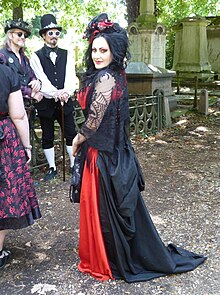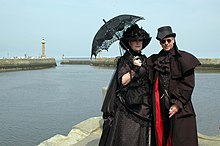Gothic fashion

Gothic fashion is a clothing style marked by dark, mysterious, antiquated, homogeneous, and often genderless features. It is worn by members of the
.Characteristics

Cintra Wilson declares that "The origins of contemporary goth style are found in the Victorian cult of mourning."[3] Valerie Steele is an expert in the history of the style.[3]

Goth subculture is stereotyped as eerie, mysterious, and complex, and the fashion is used as an outlet to express these characteristics. Goth fashion can be recognized by its stark black clothing. Ted Polhemus described goth fashion as a "profusion of black velvets, lace, fishnets and leather tinged with scarlet or purple, accessorized with tightly laced corsets, gloves, precarious stilettos and silver jewelry depicting religious or occult themes".[4]
Nancy Kilpatrick's Goth Bible: A Compendium for the Darkly Inclined defines "poseur" for the goth scene as follows: "goth wannabes, usually young kids going through a goth phase who do not hold to goth sensibilities but want to be part of the goth crowd (...)". Kilpatrick contributor "Daoine O'" denigrates poseur goths as 'Batbabies' whose clothing is bought at [mall store] Hot Topic with their parents' money".[5]
Icons
One female role model is
Music
During the emergence of the goth subculture in 1980's London,[13] many genres of music played a large role in establishing the fashion trends - fashion spelled out the music an individual would listen to. Because of its origins, the major music inspirations during the early emergence of the goth subculture were similarly English bands. Some bands who have influence gothic fashion over the years include bands like Bauhaus, the Cure, Sisters of Mercy and Siouxsie and the Banshees.[14] The Batcave was a nightclub in London, between 1982–1986, that hosted live music and paid homage to all things goth. The interior, as described by Kelly Rankin, included cobwebbed ceilings and a real coffin at the entrance. She says that "The Batcave became iconic because it aided the progression of this movement".[13]
Variations
Deathrock
Haute goth
In 1977, Karl Lagerfeld hosted the Soirée Moratoire Noir party, specifying "tenue tragique noire absolument obligatoire" (black tragic dress absolutely required).[15] The event included elements associated with leatherman style.[15]
Goth fashion has a reciprocal relationship with the fashion world. In the later part of the first decade of the 21st century, designers such as Alexander McQueen,[3][16][17] Anna Sui,[18] Rick Owens,[17] Gareth Pugh, Ann Demeulemeester, Philipp Plein, Hedi Slimane, John Richmond, John Galliano,[3][16][17] Olivier Theyskens[17][19] and Yohji Yamamoto[17] brought elements of goth to runways.[3] This was described as "Haute Goth" by Cintra Wilson in the New York Times.[3] Thierry Mugler, Claude Montana, Jean Paul Gaultier and Christian Lacroix have also been associated with a gothic style.[16] In Spring 2004, Riccardo Tisci, Jean Paul Gaultier, Raf Simons and Stefano Pilati dressed their models as "glamorous ghouls dressed in form-fitting suits and coal-tinted cocktail dresses".[19] Swedish designer Helena Hörstedt and jewelry artist Hanna Hedman also practice a goth aesthetic.[20]
Gothic Lolita
Gothic Lolita fashion is characterized by darker make-up and clothing.[22] Red lipstick and smoky or neatly defined eyes, created using black eyeliner, are typical styles, although as with all lolita sub-styles the look remains fairly natural.[23] Though Gothic make-up has been associated with a white-powdered face, this is usually considered poor taste within the (largely Japanese) lolita fashion scene.[24]
Brands which exemplify the Gothic Lolita style include Atelier-Pierrot, Atelier Boz, Black Peace Now,
Aristocrat
Cybergoth

The
Traditional goth
Traditional goth (or trad goth) is a term defining the aesthetic that reflects the classic and original aesthetics of Goth from the 1980s. The examples are from the attire worn by Bauhaus, Siouxsie Sioux and the Cure. Dominantly black clothing,
Victorian goth

Victorian goth is a modern fashion movement that interprets and redefines certain aspects regarding fashion of the Victorian Era.[30] The Victorian Era is notable for having big dresses and elegant hair, and these elements have made subsequent integration into modern day main stream gothic fashion. With early inspiration taken from medieval settings that were used by Edgar Allen Poe, in addition to late-Victorian examples of gothic fashion that are used in Bram Stoker's Dracula.[31]
Social media influence
Social media has increased the level of awareness surrounding gothic fashion trends, but this has also modified the dynamic and expectations within the community itself.[14] Bianca Wooden describes the emergence of a new wave of goth fad fashion and says that "goth has become less of an organic movement and more of a calculated brand".[14]
Performative gothic fashion
Goth YouTuber Angela Benedict describes in this video, some of the negative impacts that social media has had on gothic fashion. Some of these include the increased emergence of "elitist goths"[14] who shame others for not being "goth" enough. This has led to many online goths who portray their gloomy attire and dramatic makeup looks only to take pictures or film videos.[14]
See also
- Body image
- Heavy metal fashion
- Fetish fashion
- New Gothic Art
- Punk fashion
- Goth subculture
- Occult
Fashion accessories
- Choker
- Fishnet
- High-heeled shoes
- Pointed boots
- Thigh-high boots
- Corset
References
- Footnotes
- ^ a b c d e Grunenberg 1997, p. 172
- S2CID 196182083.
- ^ a b c d e f Wilson, Cintra (17 September 2008). "You just can't kill it". New York Times. Retrieved 18 September 2008.
- ^ Polhemus 1994, p. 97
- ^ Nancy Kilpatrick. Goth Bible: A Compendium for the Darkly Inclined. St. Martin's Griffin, 2004, p. 24
- ^ Hannaham 1997, p. 93
- ^ a b Steele & Park 2008, p. 26
- ^ Reynolds, p. 425.
- ^ Hannaham 1997, p. 113
- ^ Steele & Park 2008, p. 18
- ^ Steele & Park 2008, p. 38
- ^ Holiday, Steven (12 December 2014). "Gothic Beauty". Portland, OR: Holiday Media. Retrieved 12 December 2014.
{{cite journal}}: Cite journal requires|journal=(help) - ^ a b "The Batcave Club, London: Where the 1980s goth movement began". 7 October 2020. Retrieved 12 December 2021.
- ^ a b c d e Wooden, Bianca (13 November 2016). "Goths On Social Media Are Changing the Subculture". Millennial Influx. Retrieved 12 December 2021.
- ^ a b Steele & Park 2008, p. 35
- ^ a b c Grunenberg 1997, p. 173
- ^ a b c d e Steele & Park 2008, p. 3
- ISBN 978-1452128597– via Google Books.
- ^ a b La Ferla, Ruth: "Embrace the Darkness". New York Times, 30 October 2005. [1]
- ^ Johanna Lenander, "Swede and Sour: Scandinavian Goth," New York Times: T Magazine, 27 March 2009. [2] Access date: 29 March 2009.
- ^ [3] Archived 21 March 2012 at the Wayback Machine
- About.com. Retrieved 10 May 2010.
- ^ Anonymous (2002). "Gothic Lolita Hair and Make Up". Gothic & Lolita Bible. 4. Nuuberuguu: 79.
- ^ Anonymous (2002). "Neo Gothic Style". Gothic & Lolita Bible. 4. Nuuberuguu: 81.
- ^ Anonymous (2002). "Artist Brands: Part 1, Mana x Moi-mene-Moitie". Gothic & Lolita Bible. 4. Nuuberguu: 23.
- ^ Dead fashionable. Theage.com.au (13 September 2002).
- ISBN 978-0-8223-3921-2, p. 47]
- ^ "Gothic Fashion & clothing : The different variations of this style". Sew Guide. 2 January 2020. Retrieved 2 January 2020.
- ^ [Baddeley, Gavin (2002). Goth Chic: A Connoisseur's Guide to Dark Culture. London: Plexus Publishing, p. 204.]
- ^ "From Conventions to Curators: Historical Gothic Victorian Fashion". The Pragmatic Costumer. 18 June 2012. Retrieved 12 December 2021.
- ^ "British Library". www.bl.uk. Retrieved 12 December 2021.
- Bibliography
- Grunenberg, Christoph (1997). "Unsolved Mysteries: Gothic Tales from Frankenstein to the Hair Eating Doll". Gothic: Transmutations of Horror in Late-Twentieth-Century Art. Boston: Mit Press. ISBN 978-0-262-57128-9. Retrieved 21 December 2011.
- Hannaham, James (1997). "Bela Lugosi's Dead and I Don't Feel So Good Either: Goth and the Glorification of Suffering in Rock Music". Gothic: Transmutations of Horror in Late-Twentieth-Century Art. Boston: Mit Press. ISBN 978-0-262-57128-9. Retrieved 21 December 2011.
- Polhemus, Ted (1994). Streetstyle: from sidewalk to catwalk. Thames and Hudson. ISBN 978-0-500-27794-2. Retrieved 21 December 2011.
- Steele, Valerie; Park, Jennifer (21 October 2008). Gothic: Dark Glamour. Yale University Press and the Fashion Institute of Technology. ISBN 9780300136944. Retrieved 21 December 2011.
External links
![]() Media related to Gothic fashion at Wikimedia Commons
Media related to Gothic fashion at Wikimedia Commons

